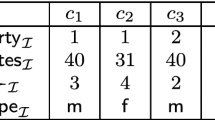Abstract
The ultimate goal of proportional apportionment methods is the minimization of disproportionality, i.e., unequal distribution of political representation among voters, or citizens. The Gini index is a well known tool for measuring inequality. In this work we propose a quotient method that minimizes the Gini index of disproportionality. Our method reduces the rounding of quotas to an instance of quadratic knapsack, a widely studied combinatorial optimization problem. Preliminary computational results, including real cases from the EU Parliament and the US House of Representatives, show that the method is effective, since the instances to solve are rather easy.





Similar content being viewed by others
Notes
See the Special Issue ‘Around the Cambridge Compromise: Apportionment in Theory and Practice’, Mathematical Social Sciences, 63(2), 65–192 (March 2012).
Available from http://www.census.gov/population/apportionment/data/.
References
Balinski, M. L., & Young, H. P. (2001). Fair representation: meeting the ideal of one man one vote. Washington: Brookings.
Caprara, A., Pisinger, D., & Toth, P. (1999). Exact solution of the quadratic knapsack problem. INFORMS Journal on Computing, 11, 125–137.
Edelman, P. H. (2006). Minimum total deviation apportionments. In B. Simeone & F. Pukelsheim (Eds.), Mathematics and democracy, studies in choice and welfare (pp. 55–64). Berlin: Springer.
Gallo, G., Hammer, P. L., & Simeone, B. (1980). Quadratic Knapsack problems. Mathematical Programming, 12, 132–149.
Gini, C. (1912). Variabilità e mutabilità. Bologna: Cuppini.
Gini, C. (1921). Measurement of inequality of incomes. The Economic Journal, 31, 124–126.
Grilli di Cortona, P., Manzi, C., Pennisi, A., Ricca, F., & Simeone, B. (1999). Evaluation and optimization of electoral systems. SIAM monographs on discrete mathematics and applications. Philadelphia: SIAM.
Grimmett, G. R. (2012). European apportionment via the Cambridge Compromise. Mathematical Social Sciences, 63(2), 68–73.
Kellerer, H., Pferschy, U., & Pisinger, D. (2004). Knapsack problems. Berlin: Springer.
Pisinger, D., Rasmussen, A. B., & Sandvik, R. (2007). Solution of large Quadratic Knapsack problems through aggressive reduction. INFORMS Journal on Computing, 19(2), 280–290.
Simeone, B. (1979). Quadratic 0–1 programming, Boolean functions and graphs. Doctoral dissertation, Waterloo University.
Xu, K. (2004). How has the literature on Gini’s index evolved in the past 80 years? Unpublished manuscript, Department of Economics, Dalhousie University, Halifax, Nova Scotia, Canada. Retrieved from http://myweb.dal.ca/kxu/, last accessed March 2013
Acknowledgements
We are grateful to two anonymous Referees for carefully reading the early versions of this paper and for providing several useful comments.
Author information
Authors and Affiliations
Corresponding author
Rights and permissions
About this article
Cite this article
Pretolani, D. Apportionments with minimum Gini index of disproportionality: a Quadratic Knapsack approach. Ann Oper Res 215, 257–267 (2014). https://doi.org/10.1007/s10479-013-1383-7
Published:
Issue Date:
DOI: https://doi.org/10.1007/s10479-013-1383-7




